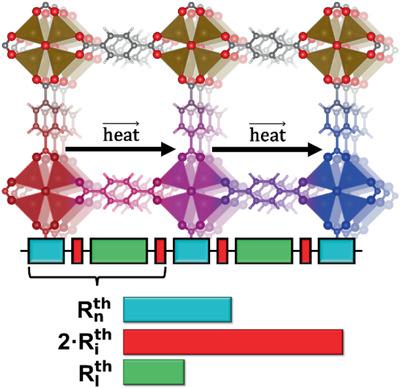当前位置:
X-MOL 学术
›
Adv. Theory Simul.
›
论文详情
Our official English website, www.x-mol.net, welcomes your
feedback! (Note: you will need to create a separate account there.)
Identifying the Bottleneck for Heat Transport in Metal–Organic Frameworks
Advanced Theory and Simulations ( IF 2.9 ) Pub Date : 2020-12-01 , DOI: 10.1002/adts.202000211 Sandro Wieser 1 , Tomas Kamencek 1, 2 , Johannes P. Dürholt 3 , Rochus Schmid 3 , Natalia Bedoya‐Martínez 4 , Egbert Zojer 1
Advanced Theory and Simulations ( IF 2.9 ) Pub Date : 2020-12-01 , DOI: 10.1002/adts.202000211 Sandro Wieser 1 , Tomas Kamencek 1, 2 , Johannes P. Dürholt 3 , Rochus Schmid 3 , Natalia Bedoya‐Martínez 4 , Egbert Zojer 1
Affiliation

|
Controlling the transport of thermal energy is key to most applications of metal–organic frameworks (MOFs). Analyzing the evolution of the effective local temperature, the interfaces between the metal nodes and the organic linkers are identified as the primary bottlenecks for heat conduction. Consequently, changing the bonding strength at that node–linker interface and the mass of the metal atoms can be exploited to tune the thermal conductivity. This insight is generated employing molecular dynamics simulations in conjunction with advanced, ab initio parameterized force fields. The focus of the present study is on MOF‐5 as a prototypical example of an isoreticular MOF. However, the key findings prevail for different node structures and node–linker bonding chemistries. The presented results lay the foundation for developing detailed structure‐to‐property relationships for thermal transport in MOFs with the goal of devising strategies for the application‐specific optimization of heat conduction.
中文翻译:

找出金属有机框架中传热的瓶颈
控制热能的传输对于金属有机框架(MOF)的大多数应用至关重要。通过分析有效局部温度的变化,可以确定金属节点和有机连接基之间的界面是热传导的主要瓶颈。因此,可以利用该节点-连接器界面处的键合强度和金属原子质量的变化来调节热导率。这种洞察力是通过分子动力学模拟与先进的从头算起的参数化力场相结合而产生的。本研究的重点是作为等网状MOF的典型例子的MOF-5。然而,关键发现普遍适用于不同的节点结构和节点-链接键键合化学。
更新日期:2021-01-14
中文翻译:

找出金属有机框架中传热的瓶颈
控制热能的传输对于金属有机框架(MOF)的大多数应用至关重要。通过分析有效局部温度的变化,可以确定金属节点和有机连接基之间的界面是热传导的主要瓶颈。因此,可以利用该节点-连接器界面处的键合强度和金属原子质量的变化来调节热导率。这种洞察力是通过分子动力学模拟与先进的从头算起的参数化力场相结合而产生的。本研究的重点是作为等网状MOF的典型例子的MOF-5。然而,关键发现普遍适用于不同的节点结构和节点-链接键键合化学。











































 京公网安备 11010802027423号
京公网安备 11010802027423号